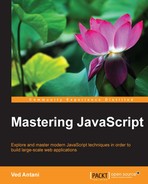In this book, you will find a number of text styles that distinguish between different kinds of information. Here are some examples of these styles and an explanation of their meaning.
Code words in text, database table names, folder names, filenames, file extensions, pathnames, dummy URLs, user input, and Twitter handles are shown as follows: "First, the <script> tag in <head> imports JavaScript, while the second <script> tag is used to embed inline JavaScript."
A block of code is set as follows:
function sayHello(what) {
return "Hello " + what;
}
console.log(sayHello("world"));When we wish to draw your attention to a particular part of a code block, the relevant lines or items are set in bold:
<head> <script type="text/javascript" src="script.js"></script> <script type="text/javascript"> var x = "Hello World"; console.log(x); </script> </head>
Any command-line input or output is written as follows:
EN-VedA:~$ node > 0.1+0.2 0.30000000000000004 > (0.1+0.2)===0.3 false
New terms and important words are shown in bold. Words that you see on the screen, for example, in menus or dialog boxes, appear in the text like this: "You can run the page and inspect using Chrome's Developer Tool"
